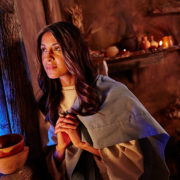God’s love: Our song forever – Part 2
Emotional pull or gospel content? How should we balance the two when choosing hymns?
Aaron L. Christie
It was my first year in the ministry, and I had the job of directing the choir. The music the church used was almost always tucked safely between the covers of the “new” hymnal. In an early effort to broaden our musical bandwidth, I picked “Soon and Very Soon” for Christ the King Sunday. I did my best to improvise a gospel-style accompaniment on the piano. As we practiced, a few members began to sway back and forth to the beat. I sat at the piano thinking, “This is going pretty well! I can’t wait to do ‘Go Tell It on the Mountain’ on Christmas!”
One comment came after the service, “Pastor, I almost felt like clapping!” That started me thinking: Why didn’t they feel like clapping for “A Mighty Fortress” a month earlier? One dear member suggested, “If we do more music like that, things will really get moving around here!” But was a Baptist-beat the musical cure for an ailing church that had just dismissed her pastor because of doctrinal differences?
Welcome to the difficult and unforgiving world of musical styles and personal preferences!
Luther’s path
What music to choose? There are times when worship planners—and even hymnal committees—would like to wish the entire topic away. The WELS Hymnal Project has received some feedback on the texts of our hymns and liturgies—what to use and what to lose. And everyone, it seems, has a comment or two when it comes to their musical preferences.
Why is that? Because music has the ability to touch human emotions. Luther recognized music’s emotional pull: “For if you want to revive the sad, startle the jovial, encourage the despairing, humble the conceited, pacify the raving, mollify the hate-filled—and who is able to enumerate all the lords of the human heart, I mean the emotions of the heart and the urges which incite a man to all virtues and vices?—what can you find that is more efficacious than music?” (What Luther Says, #3103). Other reformers such as Calvin and Zwingli were suspicious of music’s power to touch emotions. Calvin severely curtailed the use of music in worship. Zwingli went so far as to ban it from the service.
Luther took a different path. Because music is part of God’s creation, he recognized and embraced music’s ability to touch human emotions. Yet in public worship, he did not make “emotional pull” a musical prerequisite. The hymns he penned were not designed first to enable emotional expression. That purpose would be assigned to music centuries later in the tent revivals on the American frontier. Instead, Luther’s hymns were designed to put the gospel of Christ on the lips of Christ’s people. In other words, Luther’s hymns were never written to promote toe-tapping, but to enable truth telling. For Luther, content was key. And Christ is the key to Luther’s content.
Christ is key
This careful balance between music’s ability to touch emotions and music’s ability to carry Christ to the Christian can already be spotted in the title of the first Lutheran hymnal almost five hundred years ago: “Several Christian Songs, Hymns of Praise and Psalms, in Accordance with the Pure Word of God, from Holy Scripture, Produced by Various Highly Learned Individuals, for Singing in the Church, as in Part Is Already the Practice in Wittenberg.”
These first Lutheran hymns were so Christ-centered in their content, so pure in their doctrine, so biblical in their approach, and so polished in their poetry, that four of these original eight hymns are still with us today. “Dear Christians, One and All, Rejoice” (Christian Worship [CW] 377) sings the heart and core of the gospel. “Salvation Unto Us Has Come” (CW 390) pulses with the careful distinction between law and gospel. Even if someone had never opened a Bible, they could still come face to face with Jesus and their justification through these hymns. This was no accident. Luther writes: “For such songs are a sort of Bible for the uncultivated, and even for the learned. See how the pious are set on fire through these songs!” [ref.].
Does this mean that every hymn needs to be a “Dear Christians, One and All, Rejoice”? Does every hymn need to sing about the sacraments in order to be in a Lutheran hymnal? The quick answer is no. Some hymns are, by design, more of an emotional reponse to the gospel rather than a teacher of the gospel. God’s grace really is amazing (CW 379) and our Savior really is beautiful (CW 369). Some hymns are, intentionally, a commentary on God’s creation or the believer’s sanctification. We are fearfully and wonderfully made (CW 234) with hearts that yearn for the Spirit’s presence and gifts (CW 181).
But we also need to be careful. God’s grace is much more than amazing. Specifically, God’s grace is rooted in the redemption that is ours in Christ (CW 117). Our Savior is beautiful, but his beauty is seen fully in the Word and sacraments (CW 311). We are a part of God’s creation, but even more wonderfully, in Christ, we are a new creation (CW 471). Christ is the “center of gravity” in our current hymnal. Christ will remain the center of gravity in our new hymnal.
Aaron Christie, the chairman of the Hymnody Committee, is pastor at Trinity, Waukesha, Wisconisn.
This is the second article in a nine-part series on hymns and their use in our churches.
The WELS Hymnal Project wants your feedback as it works on finalizing which of the more than 700 hymns from Christian Worship and Christian Worship: Supplement will be included in the new hymnal. Every month the WELS Hymnal Project will post a selection of hymns online, indicating which hymns are slated to be kept and which are slated to be cut. You can view the monthly list and, if you want, choose up to 10 hymns from the cut list that you would like to see kept in the new hymnal. To review this month’s list of hymns and take part in the process, visit welshymnal.com.
RESPECTFULLY MAKING ROOM
Because textual content is key, the first thing the Hymnody Committee did was sit down and agree upon a set of core principles that would guide our picking and panning. Here they are:
Hymns considered for inclusion in the successor volume of Christian Worship: A Lutheran Hymnal should . . .
1. Be centered in Christ.
2. Be in harmony with the scriptural faith as confessed in the Lutheran Book of Concord.
3. Be rooted in the church year with its emphases on the life of Christ and the Christian’s life in Christ.
4. Be drawn from classic Lutheran sources and deliberately inclusive of the church’s broader song (including so-called international or global music.)
5. Be superlative examples of their genre in regard to both textual content and musical craft.
6. Be accessible and meaningful for God’s people at worship in both public and private settings.
7. Be useful for those who preach and teach the faith.
8. Be parts of a body (corpus) of hymns that will find wide acceptance by the vast majority of our fellowship.
Your Hymnody Committee is doing its best to follow the careful path that Luther blazed. We recognize and appreciate the emotional pull of music. But even more, we hope to deliver a hymnbook packed with hymns that preach, teach, and proclaim Christ crucified to a generation yet unborn. The Lord requires nothing less. God’s people deserve nothing less.
In short: Some of our new hymns will be toe tappers, but the entire hymnal will be a truth teller!
SUBMIT YOUR STORY
Do you have a manuscript, idea, or story from your own life you’d like to share for use in Forward in Christ or on wels.net? Use our online form to share it to our editorial office for consideration.
SUBSCRIBE TO FORWARD IN CHRIST
Get inspirational stories, spiritual help, and synod news from Forward in Christ every month. Print and digital subscriptions are available from Northwestern Publishing House.
Author: Aaron L. Christie
Volume 104, Number 8
Issue: August 2017
Copyrighted by WELS Forward in Christ © 2021
Forward in Christ grants permission for any original article (not a reprint) to be printed for use in a WELS church, school, or organization, provided that it is distributed free and indicate Forward in Christ as the source. Images may not be reproduced except in the context of its article. Contact us


